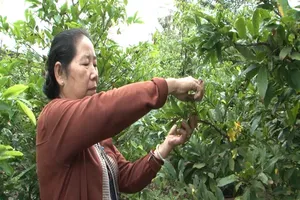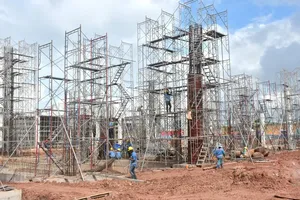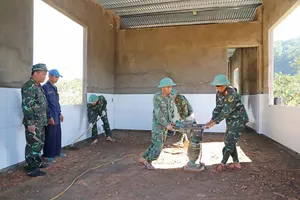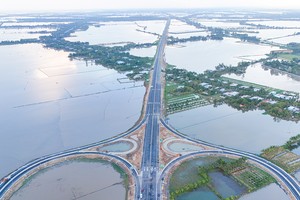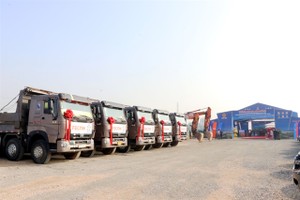Particularly, in the past few days, authorities have organized 27 receiving points with a total volume of more than 45,342 cubic meters of freshwater, providing for more than 6,744 households growing durian trees. Of which, there are 17 places in Cai Lay District, receiving 32,249 cubic meters of freshwater; three places in Chau Thanh District, receiving 8,400 cubic meters; seven places in Cai Lay Town, receiving 4,693 cubic meters. The People’s Committee of Tien Giang Province has spent about VND37 billion to hire barges to transport fresh water from Dong Thap Province to save orchards in the province, of which, durian trees are prioritized due to high risks of losses. At the same time, the People’s Committee of districts also had to disburse tens of billions of Vietnamese dong to unload and transport freshwater from barges to receiving points in rural areas to provide for people. This operation will be continuously carried out until April 30.
Mr. Nguyen Thien Phap, Head of the Department of Irrigation of Tien Giang Province, said that the provincial authorities on March 21 conducted a field survey of about 1,000 hectares of dragon fruit plants in Go Cong Dong, Go Cong Tay, and Cho Gao districts that are suffering a lack of water due to saltwater intrusion and drought. After the field survey, authorities will have solutions to supply fresh water to save orchards in these areas as drought and saltwater intrusion remain developing complicatedly.
According to Mr. Phap, authorities also placed around 67 public faucets in Go Cong Dong, Go Cong Tay, and Tan Phu Dong districts to provide fresh water for free for people in coastal areas and along the river who lack water for daily living needs. Tien Giang Water Supply Company also opened 48 water supply points in areas that face a shortage of water in these aforesaid districts.
The agriculture and rural development of Tien Giang province noted that saltwater intrusion in the Tien River has passed the intake areas of Tien Giang Water Supply Company and Dong Tam Water Supply Joint-Stock Company while the demand for water is increasing so the water supply pressure is currently weaker than usual. Therefore, the province recommended that people should only use water for daily living needs and avoid using water from the water supply stations for other purposes.
In related news, according to the National Center for Hydro-Meteorological Forecast, in the next 10 days, the Southern region will continue to see fewer rains and sunny days. Provinces in the Southeast region will experience high temperatures from 35 to 37 degrees Celsius, and provinces in the Mekong Delta have temperatures from 32 to 34 degrees Celsius. Humidity at noon and in the afternoon will be fairly low, ranging from 45 to 55 percent.
From March 21 to 26, saltwater intrusion in the Mekong Delta tends to slightly increase then gradually decreases. The highest salinity level during this period will be lower than that in the period from March 11 to 20. From April 1 to 5, saltwater intrusion will continue to decline, provinces should take advantage of this opportunity to store freshwater as soon as possible but when watering their orchards, farmers need to test strictly the salinity water to avoid losses.
Meanwhile, drought and saltwater intrusion in the Central provinces have become more severe. In the next ten days, it will be sunny with less rain; the rainfall is lower than the average level of many years by 40-80 percent. In the South Central Coast and the Central Highlands, there will be no rains. Therefore, in the next days, the water level in rivers in these regions will recede gradually with some rivers possibly seeing the lowest water level compared to the same period in previous years. The water levels of most rivers are lower than the same period in previous years by from 20 to 75 percent, or even more than 85 percent at some places. Therefore, in the next week, drought and saltwater intrusion in the Central of Vietnam will be worse and more complicated.
Mr. Nguyen Thien Phap, Head of the Department of Irrigation of Tien Giang Province, said that the provincial authorities on March 21 conducted a field survey of about 1,000 hectares of dragon fruit plants in Go Cong Dong, Go Cong Tay, and Cho Gao districts that are suffering a lack of water due to saltwater intrusion and drought. After the field survey, authorities will have solutions to supply fresh water to save orchards in these areas as drought and saltwater intrusion remain developing complicatedly.
According to Mr. Phap, authorities also placed around 67 public faucets in Go Cong Dong, Go Cong Tay, and Tan Phu Dong districts to provide fresh water for free for people in coastal areas and along the river who lack water for daily living needs. Tien Giang Water Supply Company also opened 48 water supply points in areas that face a shortage of water in these aforesaid districts.
The agriculture and rural development of Tien Giang province noted that saltwater intrusion in the Tien River has passed the intake areas of Tien Giang Water Supply Company and Dong Tam Water Supply Joint-Stock Company while the demand for water is increasing so the water supply pressure is currently weaker than usual. Therefore, the province recommended that people should only use water for daily living needs and avoid using water from the water supply stations for other purposes.
In related news, according to the National Center for Hydro-Meteorological Forecast, in the next 10 days, the Southern region will continue to see fewer rains and sunny days. Provinces in the Southeast region will experience high temperatures from 35 to 37 degrees Celsius, and provinces in the Mekong Delta have temperatures from 32 to 34 degrees Celsius. Humidity at noon and in the afternoon will be fairly low, ranging from 45 to 55 percent.
From March 21 to 26, saltwater intrusion in the Mekong Delta tends to slightly increase then gradually decreases. The highest salinity level during this period will be lower than that in the period from March 11 to 20. From April 1 to 5, saltwater intrusion will continue to decline, provinces should take advantage of this opportunity to store freshwater as soon as possible but when watering their orchards, farmers need to test strictly the salinity water to avoid losses.
Meanwhile, drought and saltwater intrusion in the Central provinces have become more severe. In the next ten days, it will be sunny with less rain; the rainfall is lower than the average level of many years by 40-80 percent. In the South Central Coast and the Central Highlands, there will be no rains. Therefore, in the next days, the water level in rivers in these regions will recede gradually with some rivers possibly seeing the lowest water level compared to the same period in previous years. The water levels of most rivers are lower than the same period in previous years by from 20 to 75 percent, or even more than 85 percent at some places. Therefore, in the next week, drought and saltwater intrusion in the Central of Vietnam will be worse and more complicated.

